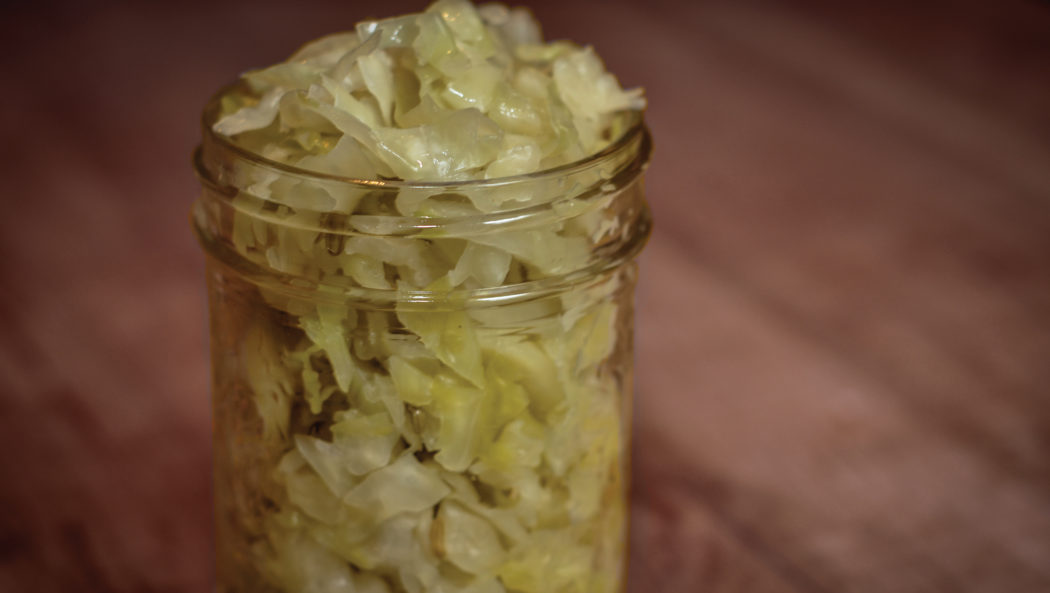With the abundance of produce on PEI this time of year, the effort to preserve and store vegetables for the winter has already begun. When looking at the many preserving methods, the health benefits of fermentation deserve attention.
Fermentation involves breaking down food using microorganisms. Quite often these microbes naturally occur, as is the case with sauerkraut; the microbes on cabbage lead to fermented cabbage. This highlights the importance of organic vegetables, as often these microbes come from healthy, living soil. The science behind how fermentation works is complex, however, the process itself is easy to accomplish in a clean home kitchen, with no specialized equipment required.
Why ferment? The human digestive system is supported by a diverse collection of microbes, or probiotics, and eating probiotic-rich foods supports this process. Research continues to suggest that the human micro-biome is fundamental to good health, with active roles in digestion, mood, immune function and more. Fermented foods are one example of how to supply our bodies with healthy probiotics, and there is no easier place to start than with humble sauerkraut, made with only cabbage and salt.
Here’s an easy and excellent sauerkraut recipe by Sandor Ellix Katz that I use regularly
What you’ll need:
- one organic cabbage, green or purple
- 2 – 3 tbsp of sea salt, finely ground
- a good knife
- a wide mouthed glass jar or bucket, and a smaller one that fits just inside the first
- a bowl (preferably glass) for massaging and mixing the cabbage
- a clean pillowcase or a towel to cover the jar
How to:
- Clean your larger jar and the outside of your smaller one. Set aside to dry.
- Chop or grate your cabbage, roughly the same size throughout. Save one whole outside leaf.
- Sprinkle some of the salt on the cabbage bits as you go. Layer cabbage, a sprinkle of salt, cabbage, salt, etc until the whole cabbage has been chopped.
- Massage the cabbage and salt with clean hands. The cabbage should start to ‘sweat’, so you will see some water at the base of the bowl.
- Pack the cabbage into the bigger jar tightly. Use your fists, or another sturdy object to pack it in well.
- Use the leftover outside leaf to cover the chopped cabbage. Place your smaller jar, filled with water and tightly covered, as a weight to press down the cabbage.
- Ideally, the top leaf is under the salty water, or brine, at this point. If not, periodically press down on the weight jar to compress the cabbage further. After 24 hours, you want the cabbage to be under brine. This prevents the cabbage from molding. If it isn’t under brine, add another weight on top of the jar (a heavy book?) or add a bit more brine to the larger jar. (1 tbsp salt to 1 cup water is a good ratio).
- Leave it to ferment! It should be in a cool, dark spot in your kitchen.
- Check it every so often. Make sure your cabbage stays under brine. If there is a mold on top, gently skim it off.
- Test after a week and see how it tastes! I generally leave mine 3-6 weeks, but it does depend on the temperature and how crunchy you like it. Keep taste-testing and re-packing the rest. Keep your kraut in the fridge in between meals once it tastes the way you like.
There are endless variations on this basic sauerkraut. It can be a fun and creative process that yields a tasty and nutritious food, and the time is now to experiment with a local cabbage, freshly picked by your favourite farmer.
Cassandra Goodwin, ND
The information provided is intended solely for educational purposes and is not a substitute for the personalized medical advice provided by a physician or other health care professional.
- Brewing Up a Love for Kombucha - March 1, 2017
- Wildcrafting on Epekwit’k - December 1, 2016
- Sauerkraut – Fermenting for Digestion - November 1, 2016
- The Immune-Boosting Wonders of the Elderberry - October 1, 2016


